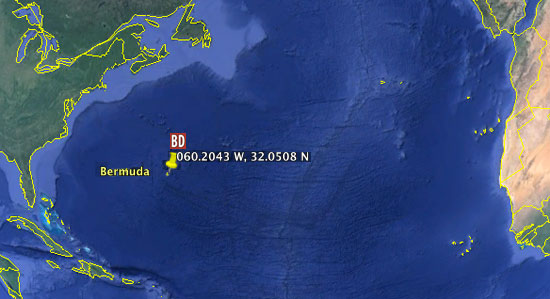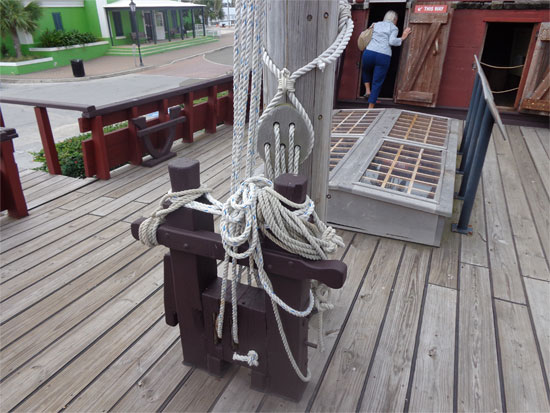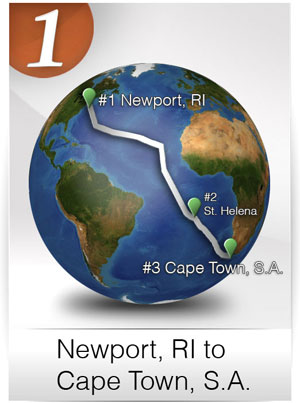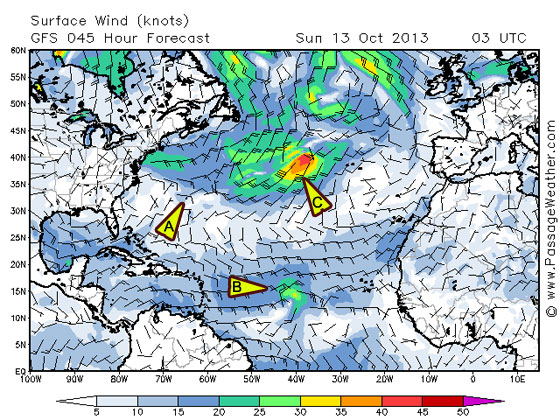:: LATEST NEWS: Tuesday we were really cooking for a while. Starting around sunset, we had a thrilling night of fast sailing as we rode the winds of the squalls on the inner edge of the cold front. That lasted until about 10 pm – about 4 hours, during which time, we were blasting along at over 10 knots in swirling rains. Let me tell you – most refreshing … and with the winds pushing in the right direction too. But unfortunately, we missed catching up to and riding the outer bands of the tropical storm Lorenzo … (which has begun to dissipate anyway.) So, as I write this then late Wednesday, we’re drifting along at just 2 to 3 knots.
There may be some westerly winds coming tomorrow, but after that, I’m going to have to head south until I catch the trade winds … one of those “whatever it takes” scenarios. This will likely mean some motor sailing, which will put me back again to the fuel calculations. It’s a long way to Cape Town yet – still about 5700 miles and probably more with the course changes. Overall, I’m just over 1000 miles from Newport, RI, where we started. So, that’s the brief update.
That said, allow me then to catch you up on some recent happenings.
:: DOLPHINS: Sunday, while working below decks, I heard strange noises. I came up to discover a pod of dolphins swimming around the boat. I could see more a ways off in the distance. This was my first sighting of the dolphins on this trip, and what a thrill it always brings to me. They are such thoroughly graceful and magical creatures, swimming wherever and however they want, gliding through the water slowly or swiftly and never once getting hit by the boat. I took some video of them and that’s here. (Be patient, they do appear towards the end.)
A Dolphin Drop-by …
I believe, from looking in the books that Tegan gave me, that these particular guys were “Pantropical Spotted Dolphins.” Hopefully, Tegan can confirm that when she sees the video.
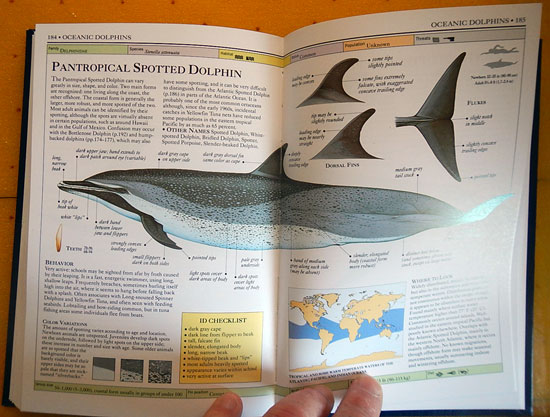 Pantropical Spotted Dolphins …
Pantropical Spotted Dolphins …
There were just a few that swam near the boat, but I could see a larger group of them … off in the distance, for about an hour – along with other fish jumping and swimming about. Just imagine having a playground that is as expansive as the oceans are? Travel where you want, swim, play, eat and carry on. Find a boat to swim around, an island to visit, and some waves to jump. They seem so free and expressive and connected to each other. Somewhere in my heart, I can’t help but think the dolphins are trying to tell us something – something they want to share with us. I hope it’s something good! I will keep observing and listening and let you know as soon as I get a good translation.
:: CITIZEN SCIENCE EXPERIMENT: After so many years of sailing on the Great Lakes and the world’s oceans … (I can’t begin to tell you how many days or how many miles that’s been,) but one thing that has always bothered me, is how fellow sailors have this habit of taking an empty aluminum can, crunching it and then casually tossing it overboard. I would always try to rescue then cans before the crunch and toss happened. Now, I’ve heard guys say that aluminum cans only last 3 days in salt water … but submerged without oxygen, I doubt that very much. But what if it is exposed to oxygen? What then?
Since I occasionally have some time on my hands here, and I have a bucket as well as the small, aluminum wrappers that my consumed Dark Chocolate Hershey’s Kisses come in … I thought … let’s put them all together and see what happens. So, I have floating in a bucket of seawater, one wrapper from a Hershey’s Kiss. It’s been three days now, and I’m seeing some discoloration on it, but it’s entirely still intact and hasn’t disintegrated yet.

Candy Science?
Now this is pretty thin foil compared to aluminum can … so I don’t think at this point, three days is anywhere near the right number. While I do know that aluminum corrodes quickly in salt water as do so many other things, it’s not going to disappear in three days. Yesterday, while I was closely inspecting the foil, I thought to myself … so why would you throw a can overboard anyway? Why go through the whole process of making a new can from scratch, when the one you just tossed overboard could be recycled and re-fabricated into another can? At the bottom of the ocean, even if it disintegrates, it can still never be recycled? Well, there’s just my personal take on the subject. I’m going to keepthat foil in the bucket and change the water ever couple of days. I’ll let you know if it’s still there when I get to Cape Town!
:: ASK DAVE A QUESTION (#1): I’ve received a number of questions (many from kids) that I’d like to begin to take some time to answer here. I really enjoy the way young inquisitive minds work, and I’ll bet some of these questions and answers will prove interesting to older friends and to adults too.
Here’s the first one … “How do you sleep and drive at the same time?”
 Well, the first step is putting the boat on autopilot – a very critical part of modern-day solo sailing – (and I will explain it in more detail very soon.) But just because the autopilot is steering the boat doesn’t mean I can stop being aware of everything that’s happening. Sleeping out here is not the same as how you sleep at home. Here, I just nap – maybe 15 to 20 minutes at a time. I have two spots I like to curl up on the boat. One is in the cockpit where I wear my harness and tether when I’m sleeping, so if I have to jump up in a hurry, I don’t trip over something and end up overboard. This spot also allows me to see the instruments, the helm and the waves or stars at night.
Well, the first step is putting the boat on autopilot – a very critical part of modern-day solo sailing – (and I will explain it in more detail very soon.) But just because the autopilot is steering the boat doesn’t mean I can stop being aware of everything that’s happening. Sleeping out here is not the same as how you sleep at home. Here, I just nap – maybe 15 to 20 minutes at a time. I have two spots I like to curl up on the boat. One is in the cockpit where I wear my harness and tether when I’m sleeping, so if I have to jump up in a hurry, I don’t trip over something and end up overboard. This spot also allows me to see the instruments, the helm and the waves or stars at night.
 Typically, we figure that the horizon is about 15 minutes away. By that we mean, at the speed we are traveling relative to the closing distance of a ship still just over the horizon (the curve of the earth) the two vessels would take about 20 minutes to cross each other. That means that any ship that I can’t see that is just over the horizon, is about 20 minutes away. To keep me in the game then, I set a small kitchen timer for 15 minutes and rest my head down.
Typically, we figure that the horizon is about 15 minutes away. By that we mean, at the speed we are traveling relative to the closing distance of a ship still just over the horizon (the curve of the earth) the two vessels would take about 20 minutes to cross each other. That means that any ship that I can’t see that is just over the horizon, is about 20 minutes away. To keep me in the game then, I set a small kitchen timer for 15 minutes and rest my head down.
Over time, I’ve also gotten very good at “feeling” the boat, especially when the sailing is smooth and steady. I’ve become quick to sense when anything is “different,” at which point, I will get up and check it out. It might be a sound, a different breeze on my feet or face, a change in the angle of the boat or a shift in motion relative to the waves … all of these variables get ingrained in your sailor’s senses and when any of them change, you know you have to change something with the boat.
My other favorite resting spot is down below – on the floor and in-between two walls. I’m pretty comfortable there on my camping mattress. I can still see my instruments and I can sense the water flowing under the boat as I’m lying on top of its lower skin. It’s actually a pretty amazing place to sleep. Sometimes when I’m at home, I wish I could sleep there!
So, that’s it for the moment. I’ll be back soon with another update. We just got one from Tegan Mortimer too, on Bird Migrations … so expect that one shortly, as well.
Also, as the certainty that you will see these updates on Facebook gets sketchier, I encourage you to sign up for our Email List.
Thank you, and take care …
– Dave & Bodacious Dream
(as of 10.24.13 @ 2:35PM (CDT)
051.69974W, 30.06824N

 Now that I think of it though, if this were a thousand years ago, and there were no expressway analogies, I can totally see how sea dragons would be a logical alternative. In fact, I’m finding it’s kind of hard NOT to personify the weather … especially when there’s no one else on board with whom I can commiserate.
Typically on a regular night, by midnight, the squalls have calmed down, and we only see a couple more before dawn … but last night, they never stopped. From the time the sun set, to well after dawn, they just kept coming … so, with my first mate, “Otto” auto-piloting the boat, I ran around making adjustments to the lines, as we ploughed our way through the chaos of increasing wind speeds, sudden shifts in wind direction and the constant and crazy waves.At present, we are less than 400 miles from our waypoint, which is where we will cross into the 100-mile band of sea known as the “doldrums” (again, that’s the low-pressure area around the equator where the prevailing winds are almost always calm.) In joking with the weather gurus over at Commander’s Weather, they are assuring me that by Saturday, I’ll be complaining about not enough wind. So, it’s always something, isn’t it?
Now that I think of it though, if this were a thousand years ago, and there were no expressway analogies, I can totally see how sea dragons would be a logical alternative. In fact, I’m finding it’s kind of hard NOT to personify the weather … especially when there’s no one else on board with whom I can commiserate.
Typically on a regular night, by midnight, the squalls have calmed down, and we only see a couple more before dawn … but last night, they never stopped. From the time the sun set, to well after dawn, they just kept coming … so, with my first mate, “Otto” auto-piloting the boat, I ran around making adjustments to the lines, as we ploughed our way through the chaos of increasing wind speeds, sudden shifts in wind direction and the constant and crazy waves.At present, we are less than 400 miles from our waypoint, which is where we will cross into the 100-mile band of sea known as the “doldrums” (again, that’s the low-pressure area around the equator where the prevailing winds are almost always calm.) In joking with the weather gurus over at Commander’s Weather, they are assuring me that by Saturday, I’ll be complaining about not enough wind. So, it’s always something, isn’t it?
 Where in the Wide World We are … 37.96625W, 11.67275N
As all this action has pretty much consumed my day and nights, I haven’t seen or done much else. You can bet the local sea life knows where to go when weather’s like this. For us, with no shelter and about as far from an Irish pub as one could be, we must proceed with our regular but now increasingly difficult-to-perform tasks. Especially challenging is boiling water and pouring it into the freeze-dried dinner pouch at night; lately this is being done with great care I can assure you.
Where in the Wide World We are … 37.96625W, 11.67275N
As all this action has pretty much consumed my day and nights, I haven’t seen or done much else. You can bet the local sea life knows where to go when weather’s like this. For us, with no shelter and about as far from an Irish pub as one could be, we must proceed with our regular but now increasingly difficult-to-perform tasks. Especially challenging is boiling water and pouring it into the freeze-dried dinner pouch at night; lately this is being done with great care I can assure you. During one of the bigger squalls last night, a big wind shift caused the bucket of seawater that contained my little citizen-scientist project of decomposing aluminum foil from the candy wrapper to tip over. But I can say, at this point, 50% of the foil was still intact with the balance broken into smaller pieces. In time, I suspect it would all disappear. How long? Not sure.
During one of the bigger squalls last night, a big wind shift caused the bucket of seawater that contained my little citizen-scientist project of decomposing aluminum foil from the candy wrapper to tip over. But I can say, at this point, 50% of the foil was still intact with the balance broken into smaller pieces. In time, I suspect it would all disappear. How long? Not sure.




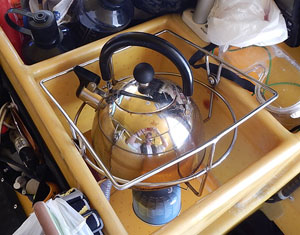






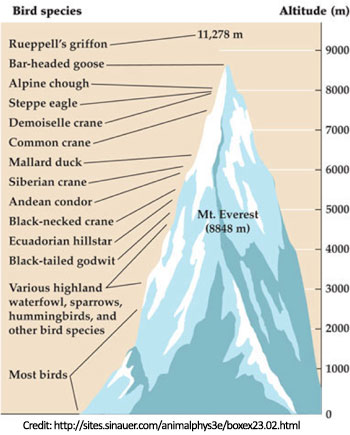




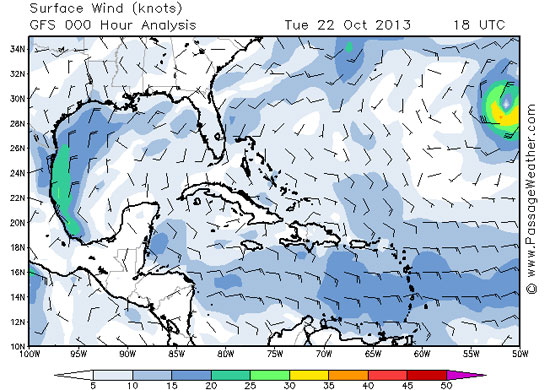



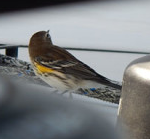 “I’m happy to report that Dave’s bird sighting has been
“I’m happy to report that Dave’s bird sighting has been 

